
The Crown Jewels of the United Kingdom, originally the Crown Jewels of England, are a collection of royal ceremonial objects kept in the Jewel House at the Tower of London, which include the coronation regalia and vestments worn by British monarchs.
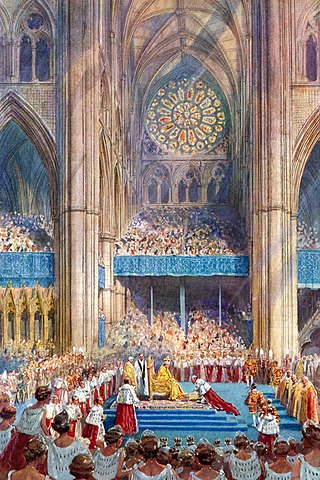
The coronation of the monarch of the United Kingdom is an initiation ceremony in which they are formally invested with regalia and crowned at Westminster Abbey. It corresponds to the coronations that formerly took place in other European monarchies, which have all abandoned coronations in favour of inauguration or enthronement ceremonies. A coronation is a symbolic formality and does not signify the official beginning of the monarch's reign; de jure and de facto his or her reign commences from the moment of the preceding monarch's death or abdication, maintaining legal continuity of the monarchy.

The Diamond Diadem, historically known as the George IV State Diadem, is a diadem that was made in 1820 for King George IV. The diadem has been worn by queens regnant and queens consort in procession to coronations and State Openings of Parliament. It has been featured in paintings and on stamps and currency.

The Honourable The King'sChampion is an honorary and hereditary office in the Royal Household of the British sovereign. The champion's original role at the coronation of a British monarch was to challenge anyone who contested the new monarch's entitlement to the throne to trial by combat. Although this function was last enacted at the coronation of George IV in 1821, the office continues to descend through the Dymoke family.
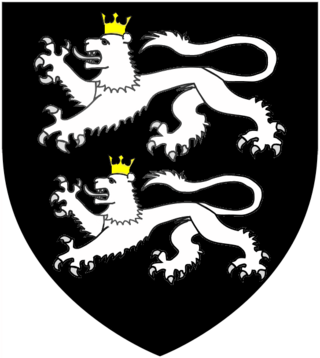
The Dymoke family of the Manor of Scrivelsby in the parish of Horncastle in Lincolnshire holds the feudal hereditary office of King's Champion. The functions of the Champion are to ride into Westminster Hall at the coronation banquet and challenge all comers who might impugn the King's title.
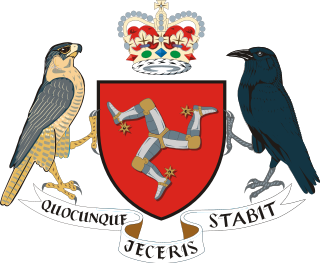
The coat of arms of the Isle of Man, blazoned Gules three legs in armour flexed at the knee and conjoined at the thigh, all proper, garnished and spurred or, dates from the late 13th century. The present version dates from 12 July 1996. As the Isle of Man is a Crown dependency and the present Lord of Man is King Charles III of the United Kingdom, the arms are more accurately described as the arms of His Majesty in right of the Isle of Man. The origin of the triskeles is obscure, but it appears to stem from the Scottish takeover of the island in 1265. The heraldic supporters are birds associated with the island, whilst the motto first appears on record in the 17th century.

The Royal Family Order of George IV is an honour that was bestowed as a mark of personal esteem on female members of the British royal family by King George IV. It was the first Royal Family Order issued in the United Kingdom. Prior to George IV's accession in 1820, both ladies and gentlemen of the Court, as well as female members of the royal family, had worn the Sovereign's portrait set in a jewelled frame. George IV formalised the order.

The Palace of Holyroodhouse, commonly known as Holyrood Palace, is the official residence of the British monarch in Scotland. Located at the bottom of the Royal Mile in Edinburgh, at the opposite end to Edinburgh Castle, Holyrood has served as the principal royal residence in Scotland since the 16th century, and is a setting for state occasions and official entertaining.

The coronation of Elizabeth II as queen of the United Kingdom and the other Commonwealth realms took place on 2 June 1953 at Westminster Abbey in London. She acceded to the throne at the age of 25 upon the death of her father, George VI, on 6 February 1952, being proclaimed queen by her privy and executive councils shortly afterwards. The coronation was held more than one year later because of the tradition of allowing an appropriate length of time to pass after a monarch dies. It also gave the planning committees adequate time to make preparations for the ceremony. During the service, Elizabeth took an oath, was anointed with holy oil, was invested with robes and regalia, and was crowned Queen of the United Kingdom, Canada, Australia, New Zealand, South Africa, Pakistan, and Ceylon.
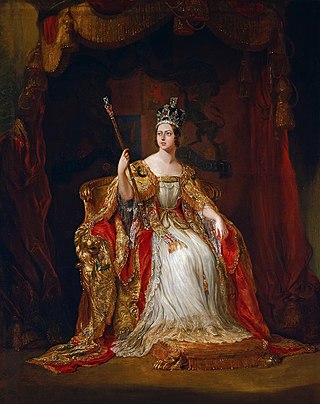
The coronation of Victoria as queen of the United Kingdom took place on Thursday, 28 June 1838, just over a year after she succeeded to the throne of the United Kingdom at the age of 18. The ceremony was held in Westminster Abbey after a public procession through the streets from Buckingham Palace, to which the Queen returned later as part of a second procession.

The coronation of George VI and his wife, Elizabeth, as king and queen of the United Kingdom and the Dominions of the British Commonwealth, Emperor and Empress consort of India took place at Westminster Abbey, London, on Wednesday 12 May 1937. George VI ascended the throne upon the abdication of his brother, Edward VIII, on 11 December 1936, three days before his 41st birthday. Edward's coronation had been planned for 12 May and it was decided to continue with his brother and sister-in-law's coronation on the same date.

The coronation of Emperor Nicholas II and his wife, Empress Alexandra Feodorovna was the last coronation during the Russian Empire. It took place on Tuesday, 14 May 1896, in Dormition Cathedral in the Moscow Kremlin. Nicholas II, known in Russian as Nikolai II Aleksandrovich, was the last emperor of Russia.
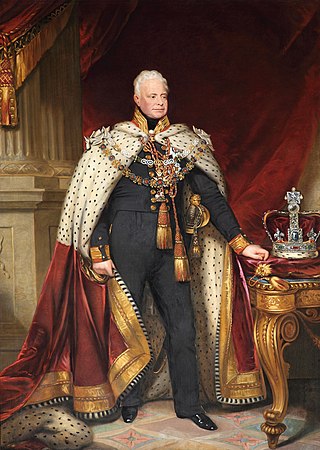
The coronation of William IV and his wife, Adelaide, as king and queen of the United Kingdom took place on Thursday, 8 September 1831, over fourteen months after he succeeded to the throne of the United Kingdom at the age of 64, the oldest person to assume the throne until Charles III in 2022. The ceremony was held in Westminster Abbey after a public procession through the streets from St James's Palace, to which the King and Queen returned later as part of a second procession.

The coronation of George IV as king of the United Kingdom took place at Westminster Abbey, London, on 19 July 1821. Originally scheduled for 1 August of the previous year, the ceremony had been postponed due to the parliamentary proceedings of George's estranged wife, Queen Caroline; because these failed to deprive Caroline of her titles and obtain a divorce from the King, she was excluded from the ceremony. In accordance with George's lavish personal tastes, the coronation was the most extravagant ever staged and a number of the traditional elements of the ceremonial were conducted for the last time.

The coronation of George III and his wife Charlotte as king and queen of Great Britain and Ireland took place at Westminster Abbey, London, on Tuesday, 22 September 1761, about two weeks after they were married in the Chapel Royal, St James's Palace. The day was marked by errors and omissions; a delayed procession from Westminster Hall to the abbey was followed by a six-hour coronation service and then a banquet that finally ended at ten o'clock at night.

The Coronation of Queen Victoria is an 1839 painting by the British artist George Hayter. It depicts in oils the Coronation of Queen Victoria at Westminster Abbey on 28 June 1838. Victoria was eighteen when she succeeded her uncle William IV to the throne on 20 June 1837 and went on to reign until 1901.

Portrait of Lord Moira is a portrait painting by the English artist Sir Joshua Reynolds of the Irish soldier and politician Francis Rawdon-Hastings, 1st Marquess of Hastings, then known as the Earl of Moira.

The Battle of Vittoria is an 1822 history painting by the British artist George Jones. It depicts the Battle of Vittoria fought in Spain on 21 June 1813 during the Napoleonic Wars. The battle resulted in a decisive victory for Allied forces led by the Duke of Wellington, effectively ending the rule of Napoleon's brother Joseph Bonaparte over Spain. Wellington is shown mounted on a white charger and is directing the final assault towards Vittoria. It is set in the early evening with French troops in disarray while British units including the Hussars, Guards and Rifles are shown in command of the field.

The Reform Banquet is a history painting by the English artist Benjamin Robert Haydon. Completed and first exhibited in 1834 it represents a scene on 11 July 1832 when supporters of the recent Reform Act including the Prime Minister Earl Grey and other government ministers met for a celebratory dinner at the Guildhall in the City of London. Comparisons have been drawn between this work and George Hayter's The House of Commons, 1833 which were both large-scale depictions related to the recent Reform Act.

Coronation Portrait of George III is a portrait painting of 1762 by the Scottish artist Allan Ramsay depicting the British monarch George III in his coronation robes. George's coronation had taken place on 22 September 1761 at Westminster Abbey, where he was crowned alongside his wife Queen Charlotte. The new king had inherited the crown from his grandfather George II in 1760 at the age of 22.



















